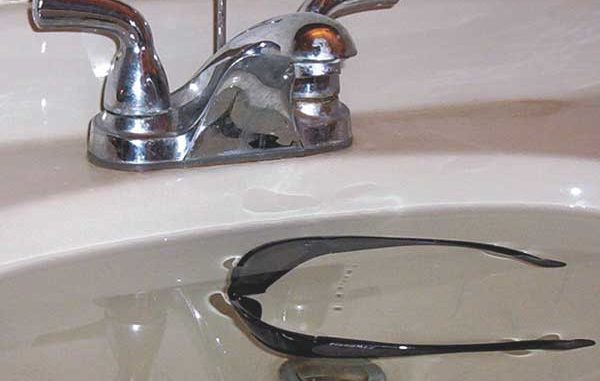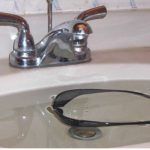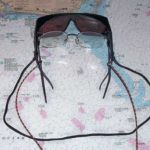
During the past couple of months. North Carolina Sportsman Magazine’s staff has attended boat and fishing shows. At many of them, I’ve noted to seminar students about how polarized sun glasses are a valuable tool.
People later visited our booth with specific questions about sun glasses.
I’m not an expert regarding polarized eyewear, but I’ve learned they’re a fishing tool that offers exceptional value.
I promised I’d research the topic to offer a broad overview of how and why polarized sun-glasses are considered valuable fishing tools. It also offers some insights into the different features and budget options.
Costa Del Mar Eyewear equates the effects of several hours in the bright sun to having a flash bulb go off in front of one’s eyes. This problem could be cumulative, and the company said it could be a cause of people’s vision problems with headlight glare while driving at night.
No doubt fishermen and watersports participants need eye protection. Going beyond basic sunglasses can be a substantial help.
I once had a specific experience where polarized sunglasses helped my team perform well during a king mackerel tournament and believe spending a few extra dollars for this eyewear was a positive investment.
My turning experience with polarized sunglasses happened during a Jolly Mon King Classic during July several years ago. Our team was sure some large kings were between Yaupon Reef (AR 425) and the Cape Fear Sea Buoy. The tide was rising that morning and our plan was to fish Yaupon Reef until the tide was almost high then move to the Cape Fear ship channel to fish high and falling tides. Shortly after 7 a.m., it was painfully clear roughly half the field also thought the winning king might come from Yaupon Reef that morning.
While we often fish perimeter structure of this reef, the large crowd constantly jockeyed for position near the reef’s buoy. We were forced to fish the perimeter or become part of the crowd. AR 425 is a shallow reef, and sometimes a large crowd pushes the fish away from the main reef, so we thought the fish would find us. They just weren’t biting yet.
After working the inshore side of the reef for an hour or so, we circled around the crowd and began working the offshore side. Just off the southeast section of the reef, we spotted a narrow tide-line strip headed offshore and roughly toward the Cape Fear Sea Buoy. The strip showed as about 10 feet of slick water, with just a light foam edge and a foot or two of current ripple at its offshore side. It was a line from a previous tide change that was slowly drifting along the edge of the current and so faint it wasn’t noticeable without polarized sunglasses.
While this wasn’t a particularly fishy-looking tide line, it was the only different piece of water that morning. Because no one was catching kings, we turned offshore and began to follow.
A couple of hundred yards down the tide line, we had our first strike, a king weighing more than 30 pounds that later earned a nice tournament check. With buoyed spirits, we continued down the fading tide line.
We fished that tide line for several hours and caught a handful of fish, including two more kings roughly the same size as our first fish, allowing our boat to win the aggregate division of the tournament. After depositing the check in the bank the next Monday, we visited a local tackle shop and outfitted the entire crew with polarized sunglasses.
That purchase continued to pay off during subsequent tournaments.
We caught those fish at a disturbance in the water we only saw by wearing polarized sunglasses. We were lucky to have stumbled across the tide line and doubly fortunate at least one of us was wearing polarized sunglasses.
After our luck — and the polarized eye wear — allowed us to find the tide line, our only real claim at fishing expertise was having enough knowledge to give it a try and enough skill to get the fish into the boat.
In addition to clarifying contrast on objects at the water’s surface, polarized sunglasses allow seeing through the glare of the light being reflected off the water, improve the ability to see into the water and aid vision in bright sunlight. Stated simply, polarized sun glasses protect vision and allow one to see things you otherwise
couldn’t.
Standard sunglasses only reduce the amount of visible light entering the eyes. Healthy eyes already have the natural ability to do this. Polarization manages the light that enters the eyes by blocking certain light rays, thus improving vision and eliminating glare.
Lenses may be polarized by laminating a polarized film to the lens or by casting it into the lens as the lens is made. Most inexpensive polarized glasses laminate the polarizing film to the lenses, while higher-end glasses cast the polarizing film into the lens.
Light reflected from horizontal surfaces, such as water, highways and early-morning mist is more than seven times brighter than ambient light and creates glare. Polarized film is a filter that blocks reflected light.
Sometimes less-expensive polarized glasses also block certain rays of light from fish finders and other marine electronics, and display screens seem to go blank. A simple, quick cure is to roll one’s head as far as it will go toward either shoulder. It isn’t comfortable but is a quick fix that will get you through the moment.
Polarized sunglasses have come a long way and numerous varieties are available. Making a decision can be a problem, but an option exists for just about anyone.
Polarized glasses begin with inexpensive models from Flying Fisherman, Sea Striker, Calcutta, Ray-Ban and several other companies. The top level is custom sunglasses by Costa Del Mar, Ocean Waves, Maui Jim and a few others.
For those who wear prescription glasses, polarized sunglasses are available in your prescription from most upper-tier companies and usually from the optician who makes your regular glasses.
If purchasing a pair of prescription polarized glasses isn’t in the budget, try clip-on polarized shades. They filter light that comes from the front but have no shielding or protection from the sides.
A pair of unique polarized products for eyeglass wearers are Fitovers (www.fitovers.com) and Cocoons (www.cocoonseyewear.com). Similar but slightly different versions of polarized glasses, they’re designed and sized to be worn over prescription lenses. Surprisingly light and comfortable, they’re available in several styles and sizes.
Cocoons and Fitovers are available through local dealers and on-line.
FishGillz offers one of the most intriguing new polarized eyewear products — floating sunglasses. They weigh about one-half ounce and float if dropped overboard.
A little more expensive than lower-tier polarized glasses, the cost is less than top-of-the-line glasses. Unfortunately, no current N.C. dealer offers them, but FishGillzes are available for $49.95 to $59.95, including shipping, at www.fishgillzusa.com.
Other companies make floating sunglasses accessories. The most common is a foam-filled strap. Another features foam-filled tubes that slide on the earpieces. Croakies and other non-floating glasses straps often prevent glasses from slipping off and falling overboard. Since fishermen are on boats and docks, some sort of glasses protection or tethers is a wise purchase.
In addition to polarization, the color of sunglasses lens influences how the bands of light pass through the lenses. There are noticeable differences in viewing, but when trying them one should sample different colored-lenses at the same time. The listings below are general characteristics of the various colors, but not everyone sees things the same way and there may be differences between wearers.
Gray lenses are considered a good general-purpose color that enhances contrast and minimizes color distortion. Gray is a good color when there isn’t much glare.
Amber lenses increase contrast in most conditions. A good general-purpose color, amber works well during cloudy or rainy days.
Vermillion lenses enhance color and heighten visual acuity and consistently deliver the brightest field of vision. The color is especially good for sight fishing, shooting, extreme sports and skiing.
Sunrise is a high-contrast specialty lens color that’s most helpful during the low-angled light of early morning and late evening. It’s especially good for extreme sports and shooting.
Blue Mirror is a color combination designed for bright sun conditions on the water. The lens is actually gray with the blue mirror encased inside the lens.
Green Mirror is a color combination that offers enhanced visual acuity for activities such as shallow-water sight fishing. The lens is actually amber with the green mirror inside the lens. Many consider it the best all-around color for driving.
Polarized eyewear in the correct color can be a positive influence for fishing. When anglers can see bait and fish moving and feeding, it’s much easier to know what lures to cast and where casts should be placed.
Correct eyewear might even help hone casting ability, especially when anglers can see where casts land and how the fish react to lures.
Special lenses also allow anglers to know if a cast was misplaced or spooked fish.






Be the first to comment